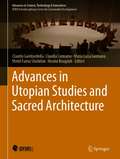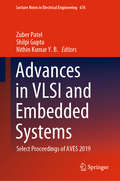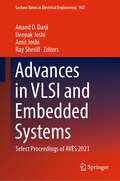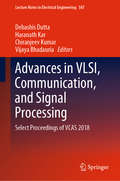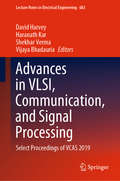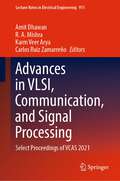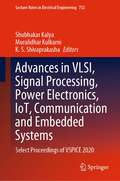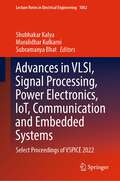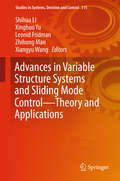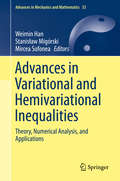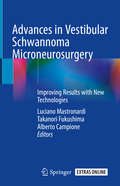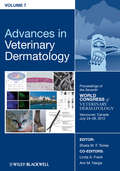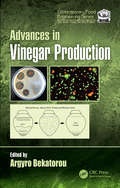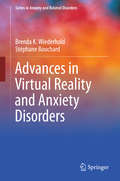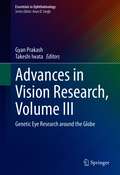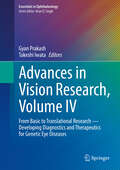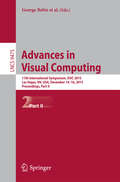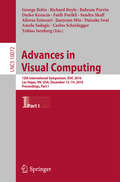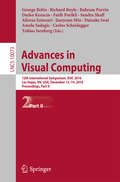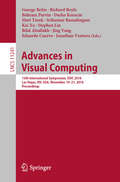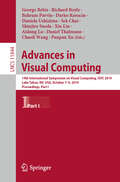- Table View
- List View
Advances in Utopian Studies and Sacred Architecture (Advances in Science, Technology & Innovation)
by Hocine Bougdah Claudio Gambardella Claudia Cennamo Maria Luisa Germanà Mohd Fairuz ShahidanAt a time dominated by the disappearance of Future, as claimed by the French anthropologist Marc Augé, Utopia and Religion seem to be two different ways of giving back an inner horizon to mankind. Therefore this book, on the one hand, considers the importance of utopia as a tool and how it offers an economic and social resource to improve cities’ wealth, future and livability. On the other, it explores the impact of religious and cultural ideals on cities that have recently emerged in this context. Based on numerous observations, the book examines the intellectual legacy of utopian theory and practices across various academic disciplines. It also presents discussions, theories, and case studies addressing a range of issues and topics related to utopia.
Advances in VLSI and Embedded Systems: Select Proceedings of AVES 2019 (Lecture Notes in Electrical Engineering #676)
by Zuber Patel Shilpi Gupta Nithin Kumar Y. B.This book presents select peer-reviewed proceedings of the International Conference on Advances in VLSI and Embedded Systems (AVES 2019) held at SVNIT, Surat, Gujarat, India. The book covers cutting-edge original research in VLSI design, devices and emerging technologies, embedded systems, and CAD for VLSI. With an aim to address the demand for complex and high-functionality systems as well as portable consumer electronics, the contents focus on basic concepts of circuit and systems design, fabrication, testing, and standardization. This book can be useful for students, researchers as well as industry professionals interested in emerging trends in VLSI and embedded systems.
Advances in VLSI and Embedded Systems: Select Proceedings of AVES 2021 (Lecture Notes in Electrical Engineering #962)
by Amit Joshi Deepak Joshi Anand D. Darji Ray SheriffThis book presents select peer-reviewed proceedings of the 2nd International Conference on Advances in VLSI and Embedded Systems (AVES 2021). This book covers cutting-edge original research in VLSI design, devices and emerging technologies, embedded systems, and CAD for VLSI. To address the demand for complex and high-functionality systems as well as portable consumer electronics, the contents focus on advanced topics of circuit and systems design, fabrication, testing, and standardization. This book is useful for students, researchers as well as industry professionals interested in emerging trends in VLSI and embedded systems.
Advances in VLSI, Communication, and Signal Processing: Select Proceedings of VCAS 2018 (Lecture Notes in Electrical Engineering #587)
by Debashis Dutta Haranath Kar Chiranjeev Kumar Vijaya BhadauriaThis book comprises select proceedings of the International Conference on VLSI, Communication and Signal processing (VCAS 2018). It looks at latest research findings in VLSI design and applications. The book covers a wide range of topics in electronics and communication engineering, especially in the area of microelectronics and VLSI design, communication systems and networks, and image and signal processing. The contents of this book will be useful to researchers and professionals alike.
Advances in VLSI, Communication, and Signal Processing: Select Proceedings of VCAS 2019 (Lecture Notes in Electrical Engineering #683)
by David Harvey Shekhar Verma Haranath Kar Vijaya BhadauriaThis book comprises select peer-reviewed papers from the International Conference on VLSI, Communication and Signal processing (VCAS) 2019, held at Motilal Nehru National Institute of Technology (MNNIT) Allahabad, Prayagraj, India. The contents focus on latest research in different domains of electronics and communication engineering, in particular microelectronics and VLSI design, communication systems and networks, and signal and image processing. The book also discusses the emerging applications of novel tools and techniques in image, video and multimedia signal processing. This book will be useful to students, researchers and professionals working in the electronics and communication domain.
Advances in VLSI, Communication, and Signal Processing: Select Proceedings of VCAS 2021 (Lecture Notes in Electrical Engineering #911)
by Karm Veer Arya Amit Dhawan R. A. Mishra Carlos Ruiz ZamarreñoThis book comprises select peer-reviewed proceedings of the International Conference on VLSI, Communication and Signal processing (VCAS 2021). The contents focus on the latest research in different domains of electronics and communication engineering, in particular microelectronics and VLSI design, communication systems and networks, and signal and image processing. The book discusses the emerging applications of novel tools and techniques in image, video, and multimedia signal processing. This book will be useful to students, researchers, and professionals working in electronics and communication.
Advances in VLSI, Signal Processing, Power Electronics, IoT, Communication and Embedded Systems: Select Proceedings of VSPICE 2020 (Lecture Notes in Electrical Engineering #752)
by Shubhakar Kalya Muralidhar Kulkarni K. S. ShivaprakashaThis book comprises select peer-reviewed papers from the International Conference on VLSI, Signal Processing, Power Electronics, IoT, Communication and Embedded Systems (VSPICE-2020). The book provides insights into various aspects of the emerging fields in the areas Electronics and Communication Engineering as a holistic approach. The various topics covered in this book include VLSI, embedded systems, signal processing, communication, power electronics and internet of things. This book mainly focuses on the most recent innovations, trends, concerns and practical challenges and their solutions. This book will be useful for academicians, professionals and researchers in the area of electronics and communications and electrical engineering.
Advances in VLSI, Signal Processing, Power Electronics, IoT, Communication and Embedded Systems: Select Proceedings of VSPICE 2022 (Lecture Notes in Electrical Engineering #1062)
by Shubhakar Kalya Muralidhar Kulkarni Subramanya BhatThis book comprises select peer-reviewed papers from the International Conference on VLSI, Signal Processing, Power Electronics, IoT, Communication, and Embedded Systems (VSPICE-2022). The book provides insights into various aspects of electronics and communication engineering as a holistic approach. The various topics covered in this book include VLSI, embedded systems, signal processing, communication, power electronics, and the Internet of Things. The contents mainly focus on the most recent innovations, trends, concerns, and practical challenges and their solutions. This book is useful for academicians, professionals, and researchers in the area of electronics and communications and electrical engineering.
Advances in Vagal Afferent Neurobiology (Frontiers in Neuroscience)
by Bradley J. Undem Daniel WeinreichTaking a comprehensive approach in which all aspects of the vagal afferent system are considered, this extensive text reviews the development, neurochemistry, anatomy, biophysics, pharmacology, and physiology of the vagal afferent nerves. The authors present experimental techniques used to investigate the development, morphology, electrophysiology and reflex function of the vagal afferent nerves, and include state-of-the-art reviews of vagal afferent neurobiology by some of the world's leading experts in these fields.
Advances in Variable Structure Systems and Sliding Mode Control—Theory and Applications: Theory And Applications (Studies in Systems, Decision and Control #115)
by Xiangyu Wang Leonid Fridman Xinghuo Yu Shihua Li Zhihong ManThis book reflects the latest developments in variable structure systems (VSS) and sliding mode control (SMC), highlighting advances in various branches of the VSS/SMC field, e. g. , from conventional SMC to high-order SMC, from the continuous-time domain to the discrete-time domain, from theories to applications, etc. The book consists of three parts and 16 chapters: in the first part, new VSS/SMC algorithms are proposed and their properties are analyzed, while the second focuses on the use of VSS/SMC techniques to solve a variety of control problems; the third part examines the applications of VSS/SMC to real-time systems. The book introduces postgraduates and researchers to the state-of-the-art in VSS/SMC field, including the theory, methodology, and applications. Relative academic disciplines include Automation, Mathematics, Electrical Engineering, Mechanical Engineering, Instrument Science and Engineering, Electronic Engineering, Computer Science and Technology, Transportation Engineering, Energy and Power Engineering, etc.
Advances in Variational and Hemivariational Inequalities: Theory, Numerical Analysis, and Applications (Advances in Mechanics and Mathematics #33)
by Mircea Sofonea Stanisław Migórski Weimin HanThis volume is comprised of articles providing new results on variational and hemivariational inequalities with applications to Contact Mechanics unavailable from other sources. The book will be of particular interest to graduate students and young researchers in applied and pure mathematics, civil, aeronautical and mechanical engineering, and can be used as supplementary reading material for advanced specialized courses in mathematical modeling. New results on well posedness to stationary and evolutionary inequalities and their rigorous proofs are of particular interest to readers. In addition to results on modeling and abstract problems, the book contains new results on the numerical methods for variational and hemivariational inequalities.
Advances in Vascular Medicine
by Michael Dashwood Gerry Coghlan Clive Handler David AbrahamThere are few books available focusing on translational science in vascular medicine, particularly in the developing field of molecular basis and clinical complications of vascular disease. Advances in Vascular Medicine contains state-of-the-art papers by world experts addressing the key frontier areas of vascular molecular and clinical medicine.
Advances in Vestibular Schwannoma Microneurosurgery: Improving Results With New Technologies
by Luciano Mastronardi Takanori Fukushima Alberto CampioneThis volume describes the most relevant and cutting-edge technological news on the complex surgical procedure of acoustic neuroma. The clinical-radiological diagnosis and surgical indications are briefly presented and the surgical technique is illustrated step-by-step: video clips show the latest means of treating these patients. All these indications were prepared by highly experienced experts in the field, based on their personal experience. The new technologies discussed concern e.g. the intraoperative identification and position of the facial nerve, hearing preservation, techniques for dural closure, and the usefulness of laser and ultrasound aspirators. The book also discusses a number of ongoing projects, including those on: diluted papaverine for microvascular protection of cranial nerves, flexible endoscope for IAC control of tumor removal, fluid cement for bone closure, administering aspirin to control residual tumors larger than 7mm, and DTI for preoperative prediction of the position of the facial nerve. This is a highly informative presented book providing surgeon interested in acoustic neuroma with necessary information on modern technologies available for improving the results of patients.
Advances in Veterinary Dermatology, Proceedings of the Seventh World Congress of Veterinary Dermatology, Vancouver, Canada, July 24-28, 2012
by Sheila M. Torres Linda Frank Ann HargisRepresenting the state of the art of veterinary dermatology around the globe, Advances in Veterinary Dermatology, Volume 7, presents selected scientific papers from the Seventh World Congress of Veterinary Dermatology. The Congress, held in Vancouver, Canada in July 2012, was organized with the support of the World Association for Veterinary Dermatology (WAVD) and its affiliated societies. A record number of delegates attended from over 50 countries to take advantage of the exceptional scientific program. Cutting edge information was presented as review papers and original studies in the areas of:AllergyImmunology Skin Biology TherapyInfectious DiseasesOncologyThese peer-reviewed and edited papers were published in the journal Veterinary Dermatology in volume 24, issue 1, and are included in this hardbound book volume of the conference proceedings. Also included are 13 Workshop Reports which summarise sessions where experts presented topics in various areas providing a wonderful opportunity for colleagues to ask questions and exchange ideas in an informal atmosphere.A vital resource for all practising veterinarians and researchers interested in the field of veterinary dermatology.
Advances in Vinegar Production (Contemporary Food Engineering #1)
by Argyro BekatorouIn industrial vinegar production, there are three main types of methods involved; the slow, handcrafted, traditional method ("Orleans" or "French" method), and the rapid submerged and generator methods. The current trend is to fuse traditional techniques with state-of-the-art technologies, and a variety of approaches have been developed to increase fermentation efficiency and reduce cost and fermentation time. This book reports on all the recent innovations in vinegar production, and compares them to the traditional submerged fermentation systems. The new trends on raw materials, substrate pretreatment strategies, alcoholic fermentation, and acetitification systems are also reviewed.
Advances in Virtual Reality and Anxiety Disorders (Series in Anxiety and Related Disorders)
by Brenda K. Wiederhold Stéphane BouchardThe interactive computer-generated world of virtual reality has been successful in treating phobias and other anxiety-related conditions, in part because of its distinct advantages over traditional in vivo exposure. Yet many clinicians still think of VR technology as it was in the 1990s-bulky, costly, technically difficult-with little knowledge of its evolution toward more modern, evidence-based, practice-friendly treatment. These updates, and their clinical usefulness, are the subject of Advances in Virtual Reality and Anxiety Disorders, a timely guidebook geared toward integrating up-to-date VR methods into everyday practice. Introductory material covers key virtual reality concepts, provides a brief history of VR as used in therapy for anxiety disorders, addresses the concept of presence, and explains the side effects, known as cybersickness, that affect a small percentage of clients. Chapters in the book's main section detail current techniques and review study findings for using VR in the treatment of: · Claustrophobia. · Panic disorder, agoraphobia, and driving phobia. · Acrophobia and aviophobia. · Arachnophobia. · Social phobia. · Generalized anxiety disorder and OCD. · PTSD. · Plus clinical guidelines for establishing a VR clinic. An in-depth framework for effective (and cost-effective) therapeutic innovations for entrenched problems, Advances in Virtual Reality and Anxiety Disorders will find an engaged audience among psychologists, psychiatrists, social workers, and mental health counselors. eractive
Advances in Vision Research, Volume I: Genetic Eye Research in Asia and the Pacific (Essentials in Ophthalmology)
by Gyan Prakash Takeshi IwataThis book presents the state of the art in genetic eye research in Asia and the Pacific. Though there has been an explosion of information on genetic eye research in western countries, more than sixty percent of the human genes involved in eye diseases in the Asian and Pacific population remain unknown. However, new efforts and a new awareness have sparked important discussions on the subject, and new plans are being implemented to discover the genes responsible for many eye diseases in the population. The book reviews the latest findings; its content ranges from genetic aspects of human migration to DNA sequence analysis, genome-wide association analysis, and disease phenotypes. The efforts of the Asian Eye Genetic Consortium (AEGC) are also discussed. The book's editors have been instrumental in developing strategies for discovering the new Asian genes involved in many eye diseases. All chapters were written by leading researchers working on Asian eye genetics from the fields of Human Genetics, Ophthalmology, Molecular Biology, Biochemistry, Sensory Sciences, and Clinical Research. Advances in Vision Research, Volume I will prove to be a major resource for all researchers, clinicians, clinical researchers, and allied eye health professionals with an interest in eye diseases among the Asian population.
Advances in Vision Research, Volume II: Genetic Eye Research In Asia And The Pacific (Essentials In Ophthalmology Ser.)
by Gyan Prakash Takeshi IwataThis second volume continues with a focus on the state of the art in genetic eye research in Asia and the Pacific. Though there has been an explosion of information on genetic eye research in western countries, more than sixty percent of the human genes involved in eye diseases in the Asian and Pacific population remain unknown. However, new efforts and a new awareness have sparked important discussions on the subject, and new plans are being implemented to discover the genes responsible for many eye diseases in the population. The book reviews the latest findings; its content ranges from genetic aspects of human migration to DNA sequence analysis, genome-wide association analysis, and disease phenotypes. The efforts of the Asian Eye Genetic Consortium (AEGC) are also discussed. The book’s editors have been instrumental in developing strategies for discovering the new Asian genes involved in many eye diseases. All chapters were written by leading researchers working on Asian eye genetics from the fields of Human Genetics, Ophthalmology, Molecular Biology, Biochemistry, Sensory Sciences, and Clinical Research. Advances in Vision Research, Volume II will prove to be a major resource for all researchers, clinicians, clinical researchers, and allied eye health professionals with an interest in eye diseases among the Asian population.
Advances in Vision Research, Volume III: Genetic Eye Research around the Globe (Essentials in Ophthalmology)
by Gyan Prakash Takeshi IwataThis third volume, with three supporting editors, broadens its focus on genetic eye research from the Asian to the global scale. New efforts and a new awareness have sparked important discussions on genetic eye research, and new plans are being implemented to identify the genes responsible for numerous eye diseases. The book introduces the latest findings on genetics in eye diseases, gene therapy, and genome-wide association analysis, and the efforts of the Global Eye Genetic Consortium (GEGC). The book’s editors have been instrumental in developing strategies for discovering the new genes involved in many eye diseases. All chapters were written by leading researchers working on eye genetics from the fields of Human Genetics, Ophthalmology, Molecular Biology, Biochemistry, Sensory Sciences, and Clinical Research. Advances in Vision Research, Volume III is a major resource for all researchers, clinicians, clinical researchers, and allied eye health professionals with an interest in eye diseases around the globe.
Advances in Vision Research, Volume IV: From Basic to Translational Research — Developing Diagnostics and Therapeutics for Genetic Eye Diseases (Essentials in Ophthalmology)
by Gyan Prakash Takeshi IwataThis fourth volume in the series Advances in Vision Research describes importance advancements in basics to translational research, including new therapeutics for genetic eye diseases. Recent US FDA approval of the first gene therapy for an inherited retinal disease, due to a mutation in the RPE65 gene, has led to an upsurge in translational eye research. The coverage in this volume includes corneal diseases, myopia, cataract, glaucoma, inherited retinal diseases, inherited optic neuropathy, and other genetic eye diseases. New developments such as the application of artificial intelligence in translational eye research are also discussed. All chapters are written by leading researchers working on eye genetics from the fields of Human Genetics, Ophthalmology, Molecular Biology, Biochemistry, Sensory Sciences, and Clinical Research. Advances in Vision Research, Volume IV will be a major resource for all researchers, clinicians, clinical researchers, andallied eye health professionals with an interest in eye diseases around the globe. The first two volumes in the series described the state of the art in genetic eye research in Asia and the Pacific while the third focused on progress in Europe and the United States.
Advances in Visual Computing: 11th International Symposium, ISVC 2015, Las Vegas, NV, USA, December 14-16, 2015, Proceedings, Part II (Lecture Notes in Computer Science #9475)
by Tim Mcgraw George Bebis Richard Boyle Bahram Parvin Darko Koracin Ioannis Pavlidis Rogerio Feris Mark Elendt Regis Kopper Eric Ragan Zhao Ye Gunther WeberThe two volume set LNCS 9474 and LNCS 9475 constitutesthe refereed proceedings of the 11th International Symposium on VisualComputing, ISVC 2015, held in Las Vegas, NV, USA in December 2015. The 115 revised full papers and 35 poster paperspresented in this book were carefully reviewed and selected from 260submissions. The papers are organized in topical sections: Part I (LNCS 9474)comprises computational bioimaging; computer graphics; motion and tracking;segmentation; recognition; visualization; mapping; modeling and surfacereconstruction; advancing autonomy for aerial robotics; medical imaging;virtual reality; observing humans; spectral imaging and processing; intelligenttransportation systems; visual perception and robotic systems. Part II (LNCS9475): applications; 3D computer vision; computer graphics; segmentation;biometrics; pattern recognition; recognition; and virtual reality.
Advances in Visual Computing: 12th International Symposium, ISVC 2016, Las Vegas, NV, USA, December 12-14, 2016, Proceedings, Part I (Lecture Notes in Computer Science #10072)
by George Bebis Richard Boyle Bahram Parvin Darko Koracin Fatih Porikli Sandra Skaff Alireza Entezari Jianyuan Min Daisuke Iwai Amela Sadagic Carlos Scheidegger Tobias IsenbergIt is with greatpleasure that we present the proceedings of the 4th International Symposium on Visual Computing (ISVC 2008) in Las Vegas, Nevada. ISVC o'ers a common umbrella for the four main areas of visual computing including vision, graphics, visualization, and virtual reality. Its goal is to provide a forum for researchers, scientists, engineers and practitioners throughout the world to present their latest research ?ndings, ideas, developments and applications in the broader area of visual computing. This year,ISVC grew signi'cantly; the programconsisted of 15 oralsessions, 1 poster session, 8 special tracks, and 6 keynote presentations. The response to the call for papers was very strong; we received over 340 submissions for the main symposium from which we accepted 102 papers for oral presentation and 70 papers for poster presentation. Special track papers were solicited separately through the Organizing and Program Committees of each track. A total of 56 papers were accepted for oral presentation and 8 papers for poster presentation in the special tracks. All papers were reviewed with an emphasis on potential to contribute to the state of the art in the ?eld. Selection criteria included accuracy and originality of ideas, clarity and signi'cance of results, and presentation quality. The review process was quite rigorous, involving two to three independent blind reviews followed by several days of discussion. During the discussion period we tried to correct anomalies and errors that might have existed in the initial reviews.
Advances in Visual Computing: 12th International Symposium, ISVC 2016, Las Vegas, NV, USA, December 12-14, 2016, Proceedings, Part II (Lecture Notes in Computer Science #10073)
by George Bebis Richard Boyle Bahram Parvin Darko Koracin Fatih Porikli Sandra Skaff Alireza Entezari Jianyuan Min Daisuke Iwai Amela Sadagic Carlos Scheidegger Tobias IsenbergIt is with greatpleasure that we present the proceedings of the 4th International Symposium on Visual Computing (ISVC 2008) in Las Vegas, Nevada. ISVC o'ers a common umbrella for the four main areas of visual computing including vision, graphics, visualization, and virtual reality. Its goal is to provide a forum for researchers, scientists, engineers and practitioners throughout the world to present their latest research ?ndings, ideas, developments and applications in the broader area of visual computing. This year,ISVC grew signi'cantly; the programconsisted of 15 oralsessions, 1 poster session, 8 special tracks, and 6 keynote presentations. The response to the call for papers was very strong; we received over 340 submissions for the main symposium from which we accepted 102 papers for oral presentation and 70 papers for poster presentation. Special track papers were solicited separately through the Organizing and Program Committees of each track. A total of 56 papers were accepted for oral presentation and 8 papers for poster presentation in the special tracks. All papers were reviewed with an emphasis on potential to contribute to the state of the art in the ?eld. Selection criteria included accuracy and originality of ideas, clarity and signi'cance of results, and presentation quality. The review process was quite rigorous, involving two to three independent blind reviews followed by several days of discussion. During the discussion period we tried to correct anomalies and errors that might have existed in the initial reviews.
Advances in Visual Computing: 13th International Symposium, ISVC 2018, Las Vegas, NV, USA, November 19 – 21, 2018, Proceedings (Lecture Notes in Computer Science #11241)
by Stephen Lin George Bebis Richard Boyle Bahram Parvin Darko Koracin Matt Turek Srikumar Ramalingam Kai Xu Bilal Alsallakh Jing Yang Eduardo Cuervo Jonathan VenturaThis book constitutes the refereed proceedings of the 13th International Symposium on Visual Computing, ISVC 2018, held in Las Vegas, NV, USA in November 2018. The total of 66 papers presented in this volume was carefully reviewed and selected from 91 submissions. The papers are organized in topical sections named: ST: computational bioimaging; computer graphics; visual surveillance; pattern recognition; vitrual reality; deep learning; motion and tracking; visualization; object detection and recognition; applications; segmentation; and ST: intelligent transportation systems.
Advances in Visual Computing: 14th International Symposium on Visual Computing, ISVC 2019, Lake Tahoe, NV, USA, October 7–9, 2019, Proceedings, Part I (Lecture Notes in Computer Science #11844)
by Daniel Thalmann Xin Lin George Bebis Richard Boyle Bahram Parvin Darko Koracin Daniela Ushizima Sek Chai Shinjiro Sueda Aidong Lu Chaoli Wang Panpan XuThis book constitutes the refereed proceedings of the 14th International Symposium on Visual Computing, ISVC 2019, held in Lake Tahoe, NV, USA in October 2019. The 100 papers presented in this double volume were carefully reviewed and selected from 163 submissions. The papers are organized into the following topical sections: Deep Learning I; Computer Graphics I; Segmentation/Recognition; Video Analysis and Event Recognition; Visualization; ST: Computational Vision, AI and Mathematical methods for Biomedical and Biological Image Analysis; Biometrics; Virtual Reality I; Applications I; ST: Vision for Remote Sensing and Infrastructure Inspection; Computer Graphics II; Applications II; Deep Learning II; Virtual Reality II; Object Recognition/Detection/Categorization; and Poster.
